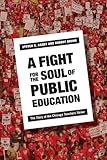A Fight for the Soul of Public Education : The Story of the Chicago Teachers Strike / Steven Ashby, Robert Bruno.
Material type: TextPublisher: Ithaca, NY : Cornell University Press, [2016]Copyright date: ©2016Description: 1 online resource (328 p.) : 11 halftonesContent type:
TextPublisher: Ithaca, NY : Cornell University Press, [2016]Copyright date: ©2016Description: 1 online resource (328 p.) : 11 halftonesContent type: - 9781501705939
- Education and state -- Illinois -- Chicago
- Strikes and lockouts -- Teachers -- Illinois -- Chicago
- Teachers -- Political activity -- Illinois -- Chicago
- Education & History Of Education
- Labor History
- U.S. History
- POLITICAL SCIENCE / Labor & Industrial Relations
- Public education, labor relations, school systems, educational governance, school board, union representatives
- 331.881137110977311
- LB2844.47.U62
- online - DeGruyter
| Item type | Current library | Call number | URL | Status | Notes | Barcode | |
|---|---|---|---|---|---|---|---|
 eBook
eBook
|
Biblioteca "Angelicum" Pont. Univ. S.Tommaso d'Aquino Nuvola online | online - DeGruyter (Browse shelf(Opens below)) | Online access | Not for loan (Accesso limitato) | Accesso per gli utenti autorizzati / Access for authorized users | (dgr)9781501705939 |
Frontmatter -- Contents -- Acknowledgments -- Introduction -- 1. EDUCATION REFORM FROM WASHINGTON TO CHICAGO -- 2. THE ERA OF MAYORAL CONTROL BEGINS -- 3. CHICAGO SCHOOL TEACHERS AND CORE -- 4. EVALUATING TEACHERS AND POLITICAL OPPORTUNISM -- 5. SENATE BILL 7 -- 6. THE CONTRACT CAMPAIGN -- 7. EMANUEL PROVOKES, TEACHERS PREPARE TO BARGAIN -- 8. THE START OF 2012 CONTRACT NEGOTIATIONS -- 9. A BREAKTHROUGH AND PRELUDE TO A STRIKE -- 10. THE STRIKE -- 11. BARGAINING DURING THE STRIKE AND A DEAL REACHED -- CONCLUSION -- NOTES -- INDEX
restricted access online access with authorization star
http://purl.org/coar/access_right/c_16ec
In reaction to the changes imposed on public schools across the country in the name of "education reform," the Chicago Teachers Union redefined its traditional role and waged a multidimensional fight that produced a community-wide school strike and transformed the scope of collective bargaining into arenas that few labor relations experts thought possible. Using interviews, first-person accounts, participant observation, union documents, and media reports, Steven K. Ashby and Robert Bruno tell the story of the 2012 strike that shut down the Chicago school system for seven days.A Fight for the Soul of Public Education takes into account two overlapping, parallel, and equally important stories. One is a grassroots story of worker activism told from the perspective of rank-and-file union members and their community supporters. Ashby and Bruno provide a detailed account of how the strike became an international cause when other teachers unions had largely surrendered to corporate-driven education reform. The second story describes the role of state and national politics in imposing educational governance changes on public schools and draconian limitations on union bargaining rights. It includes a detailed account of the actual bargaining process revealing the mundane and the transcendental strategies of both school board and union representatives.
Mode of access: Internet via World Wide Web.
In English.
Description based on online resource; title from PDF title page (publisher's Web site, viewed 26. Apr 2024)


